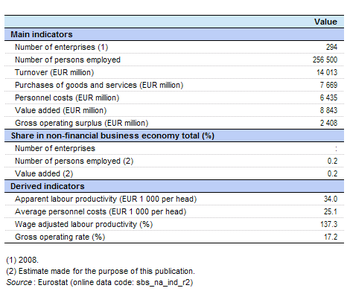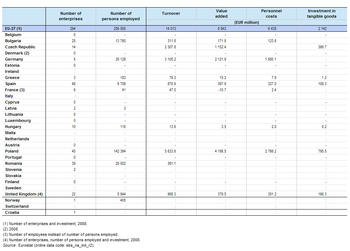Archive:Mining of coal and lignite statistics - NACE Rev. 2
- Data from April 2012. Most recent data: Further Eurostat information, Main tables and Database.
This article presents an overview of statistics for mining of coal and lignite in the European Union (EU), covering NACE Rev. 2 Division 05.


(% share of sectoral total) - Source: Eurostat (sbs_na_ind_r2)





Main statistical findings
Structural profile
Enterprises operating with mining of coal and lignite (Division 05) as their main activity employed 257 thousand persons in the EU-27 in 2009, equivalent to 0.2 % of all persons employed in the non-financial business economy (Sections B to J and L to N and Division 95) and 40 % of persons working in mining and quarrying. These enterprises generated EUR 8 843 million of value added which was also 0.2 % of the non-financial business economy total, or some 12 % of the added value for the whole of mining and quarrying.
The apparent labour productivity of the EU-27's mining of coal and lignite sector in 2009 was EUR 34.0 thousand per person employed, below the non-financial business economy average of EUR 41.6 thousand per person employed and the much higher mining and quarrying average of EUR 112 thousand per person employed. In line with this low apparent labour productivity, average personnel costs within the EU-27’s mining of coal and lignite sector were also below average: at EUR 25.1 thousand per employee compared with an average of EUR 30.0 thousand per employee for the whole of the non-financial business economy. The wage-adjusted labour productivity ratio combines the two previous indicators and shows the extent to which value added per person employed covers average personnel costs per employee. Due to relatively low productivity and only slightly inferior average personnel costs (when compared with the non-financial business economy average), the EU-27's mining of coal and lignite sector had a wage-adjusted labour productivity ratio of 137.3 % in 2009, marginally lower than the non-financial business economy average (138.8 %).
The gross operating rate (the relation between gross operating surplus and turnover) is one measure of profitability; it stood at 17.2 % for the EU-27’s mining of coal and lignite sector in 2009, a little under twice as high as the non-financial business economy average (9.7 %). It should be noted that this measure does not take account of depreciation or financial expenditure, which are typically higher in capital-intensive activities.
Sectoral analysis
The mining of coal and lignite sector is broken down in the NACE classification into two subsectors at the NACE group level of detail. The mining of hard coal (Group 05.1) was the largest of these two subsectors in terms of employment and value added in the EU-27: it generated 73.6 % of sectoral value added and occupied 75.0 % of the workforce. The mining of lignite (Group 05.2) made up the remainder of the mining of coal and lignite sector. As such, the contribution of the two subsectors to the mining of coal and lignite total was similar in terms of their shares in both sectoral value added and employment (as shown in Figure 1).
This apparent similarity was not reflected across all indicators, and differences between the two subsectors were particularly pronounced in relation to labour costs. At the NACE group level, EU-27 average personnel costs per employee were EUR 26.7 thousand per employee for hard coal mining in 2009 while they were just EUR 20.4 thousand per employee for lignite mining. The low apparent labour productivity figure for the whole of the mining of coal and lignite sector was common to both subsectors, with the mining of lignite recording a value of EUR 36 thousand per person employed, just EUR 2 thousand higher than for hard coal mining. The combination of particularly low average personnel costs and slightly higher apparent labour productivity resulted in a high wage-adjusted labour productivity ratio in lignite mining, reaching 179.1 %, well above the non-financial business economy average (138.8 %). In contrast, for hard coal mining this ratio was 126.7 %. The relatively low average personnel costs for lignite mining also helped to raise the gross operating rate in this subsector to 24.6 % in 2009, compared with 14.0 % for hard coal mining; the latter was, nevertheless, still above the non-financial business economy average (9.7 %).
Country analysis
At least nine Member States had no enterprises (and therefore no output or employment) in the mining of coal and lignite sector in 2009 – see Tables 4a and 4b. Poland recorded the highest share (47.5 %) of EU-27 value added within the mining of coal and lignite sector in 2009, while Germany and the Czech Republic were also relatively important producers in value added terms; the combined output of these three Member States was equivalent to 84.5 % of the EU-27 total output in this sector. Poland also had the largest workforce for the mining of coal and lignite, 142.4 thousand persons, over half the EU-27 total. The relatively high share of a small number of Member States in the EU-27’s value added and employment in the mining of coal and lignite sector underlined the geographical concentration and specialisation of this sector.
Poland had the highest level of value added for both of the subsectors, accounting for more than half of the EU-27’s value added in hard coal mining and just under one quarter of the total for lignite mining. Unsurprisingly, Poland was also the most specialised Member State (in value added terms) in hard coal mining (followed by the United Kingdom), while Bulgaria and Poland were the most specialised Member States for lignite mining.
Data sources and availability
The analysis presented in this article is based on the main dataset for structural business statistics (SBS) which are disseminated annually. The series provides information for each Member State as well as a number of non-member countries at a detailed level according to the activity classification NACE. Data are available for a wide range of variables.
Context
This article presents an overview of statistics for the mining of coal and lignite sector in the EU, covering NACE Rev. 2 Division 05. The extraction of solid mineral fuels such as coal and lignite includes underground or open-cast mining and includes operations (for example, grading, cleaning, compressing and other steps necessary for transportation and so on) leading to a marketable product.
This Division is composed of two Groups:
- the mining of hard coal (Group 05.1);
- the mining of lignite also known as brown coal (Group 05.2).
This article does not cover peat-digging (which is classified to Division 08, other mining and quarrying), coking or the manufacture of briquettes (Division 19, the manufacture of coke and refined petroleum products) or services incidental to coal or lignite mining (Division 09, mining support services).
Further Eurostat information
Publications
Main tables
Database
- SBS - industry and construction (sbs_ind_co)
- Annual detailed enterprise statistics - industry and construction (sbs_na_ind)
- Annual detailed enterprise statistics for industry (NACE Rev.2 B-E) (sbs_na_ind_r2)
- Preliminary results on industry and construction, main indicators (NACE Rev.2) (sbs_na_r2preli)
- SMEs - Annual enterprise statistics broken down by size classes - industry and construction (sbs_sc_ind)
- Industry broken down by employment size classes (NACE Rev.2 B-E) (sbs_sc_ind_r2)
- Annual detailed enterprise statistics - industry and construction (sbs_na_ind)
- SBS - regional data - all activities (sbs_r)
- SBS data by NUTS 2 regions and NACE Rev.2, from 2008 onwards (sbs_r_nuts06_r2)
Dedicated section
Methodology / Metadata
- Name of the destination ESMS metadata file (ESMS metadata file - ESMS code, e.g. bop_fats_esms)
- Title of the publication
Source data for tables, figures and maps (MS Excel)
Other information
- Regulation 58/1997 of 20 December 1996 concerning structural business statistics
- Decision 2367/2002/EC of 16 December 2002 on the Community statistical programme 2003 to 2007
- Regulation 295/2008 of 11 March 2008 concerning structural business statistics